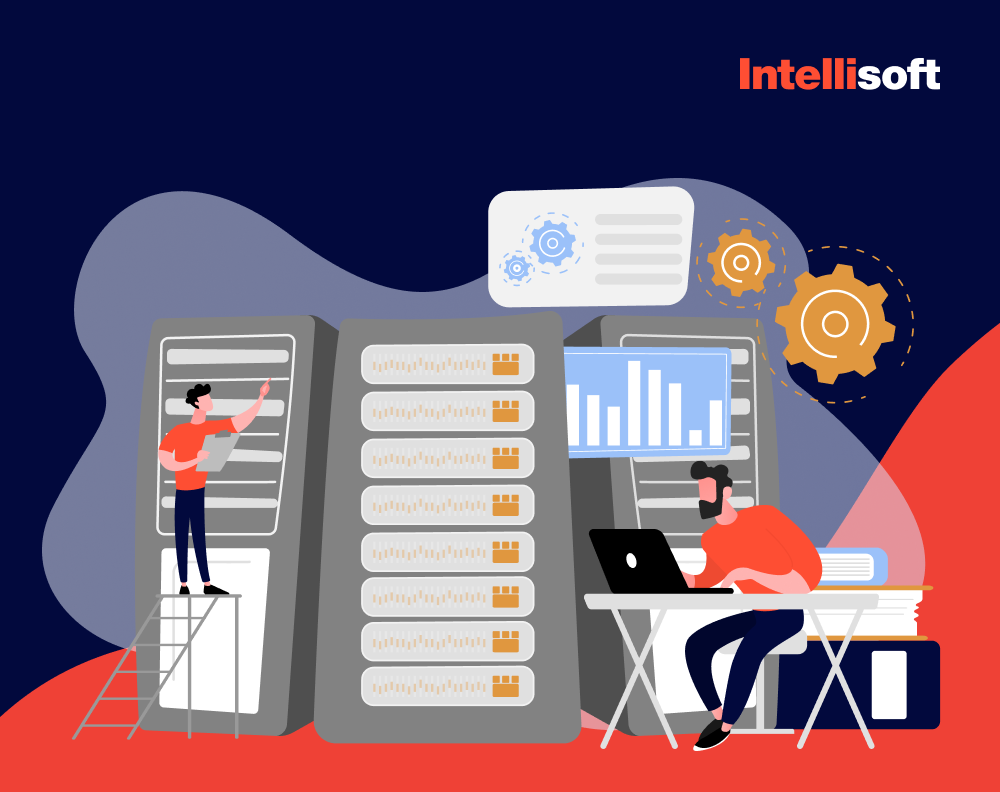At IntelliSoft, we’ve been closely monitoring the increasing demand for embedded systems, especially in North America, with Microsoft and Intel at the forefront. Although this region accounts for over 41% of the global embedded systems market, a significant challenge persists; the local talent pool is struggling to keep pace. Indeed, currently there are over 3,000 job postings for embedded engineers across the U.S., and LinkedIn reveals an even more daunting number—over 58,000 open positions.
If you’ve ever considered embedded software outsourcing for your IoT software or hardware projects, you’ve likely felt the intense competition yourself. Some companies are even relocating their headquarters to tap into broader talent pools.
But here’s the thing—you don’t have to go to such extremes to meet your development needs. Outsourcing could be an ideal solution to close that skills gap.
By partnering with a hardware and embedded engineering services firm in a talent-rich region, you can access the expertise you need without relocating or expanding your local team. While working remotely with software developers is relatively straightforward, handling remote embedded development, with all the necessary hardware and tools, might seem more complicated.
However, it’s not as tricky as it appears. With 15 years in software development, we can confidently say that outsourcing embedded development is viable and offers substantial benefits. Below, we’ll address some of the most common business’ concerns when considering this option.
As Michael Dell, founder of Dell Technologies, said, “When done right, outsourcing embedded software development helps scale your business, reduce costs, and improve time-to-market.”
Table of Contents
What is Embedded Software Development?
Embedded software development is all about crafting the “brains” behind machines and devices that we might not immediately think of as computers. Take your smart fridge, car’s infotainment system, or even medical devices—these all rely on embedded software. This software is integrated directly into the hardware, allowing the device to function properly and perform its specific duties.
Here’s what makes embedded software unique:
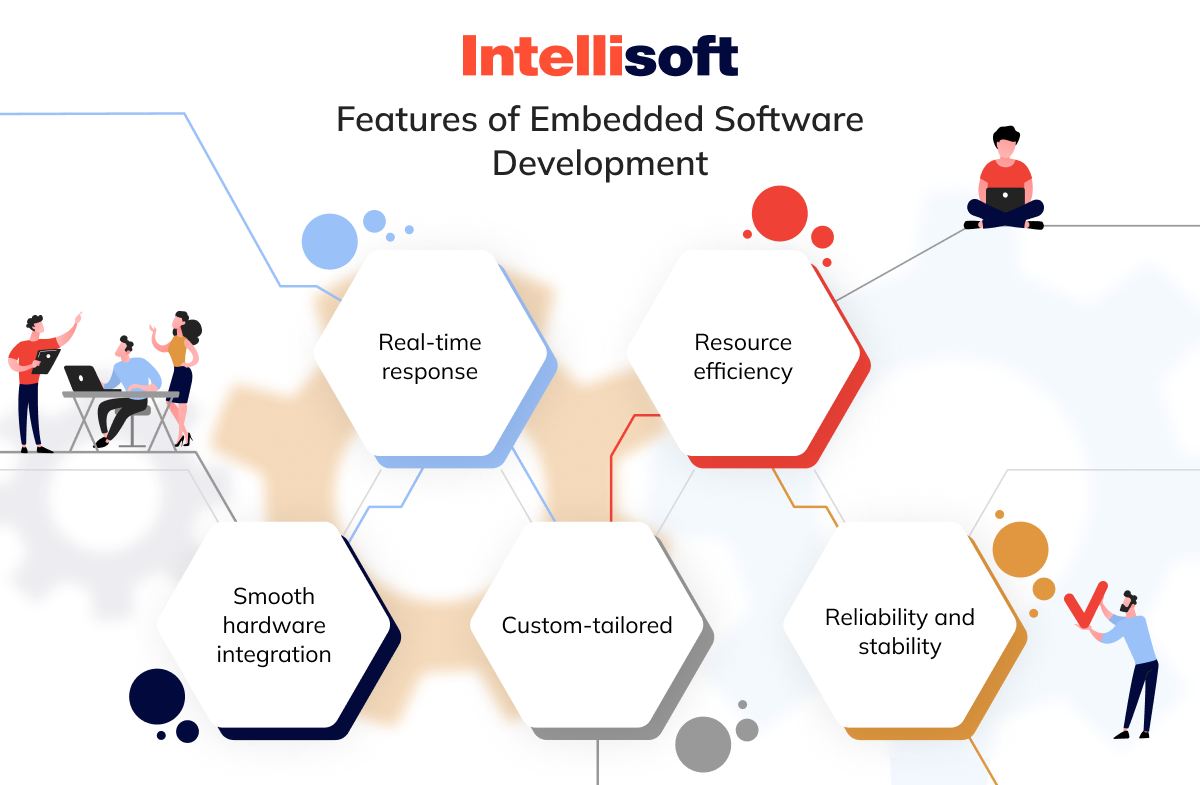
- Smooth hardware integration. The embedded software solution is built to interact seamlessly with the hardware, allowing it to manage critical functions without a hitch.
- Real-time response. Many devices must react instantly, so the software is designed to respond quickly to environmental inputs or changes.
- Custom-tailored. Each piece of software is specifically designed for the device it powers, focusing on the critical tasks defining its main function.
- Resource efficiency. Embedded systems often have limited memory and processing power, so the software is optimized to run efficiently within these constraints.
- Reliability and stability. Since the device’s performance depends on it, embedded software is built to be highly dependable and stable.
Why Is Embedded Software and Hardware Development Worth the Effort?
Embedded systems have become a cornerstone in aerospace, automotive, industrial machinery, and consumer electronics. As automation, connectivity, analytics, and the Internet of Things (IoT) grow in influence, these systems are no longer just behind the scenes—they’re now at the forefront, pushing innovation in these fields. To achieve the level of performance demanded, seamless coordination between components is critical, and much of this relies on the software driving these systems.
Take the automotive industry as an example. Embedded software is a key player in advanced driver-assistance systems (ADAS), automated driving, and in-vehicle entertainment. It’s no surprise, then, that the embedded software and hardware market has already reached billions of dollars and is expected to expand by roughly 9% by 2030, according to McKinsey.
However, technical skills alone won’t guarantee successful outsourcing embedded software projects. You need a strong vision for the end product, a deep understanding of the project’s demands, and strategies to tackle the challenges that will arise along the way.
When to Consider Embedded Software Outsourcing
Partnering with an external team could be game-changing if you plan to develop an embedded system. Outsourcing allows you to save time and reduce expenses and frees up your resources so you can channel your energy into creating new products more efficiently. Here’s why outsourcing your embedded software development might just be the strategic advantage your business needs. Let’s explore these benefits further!
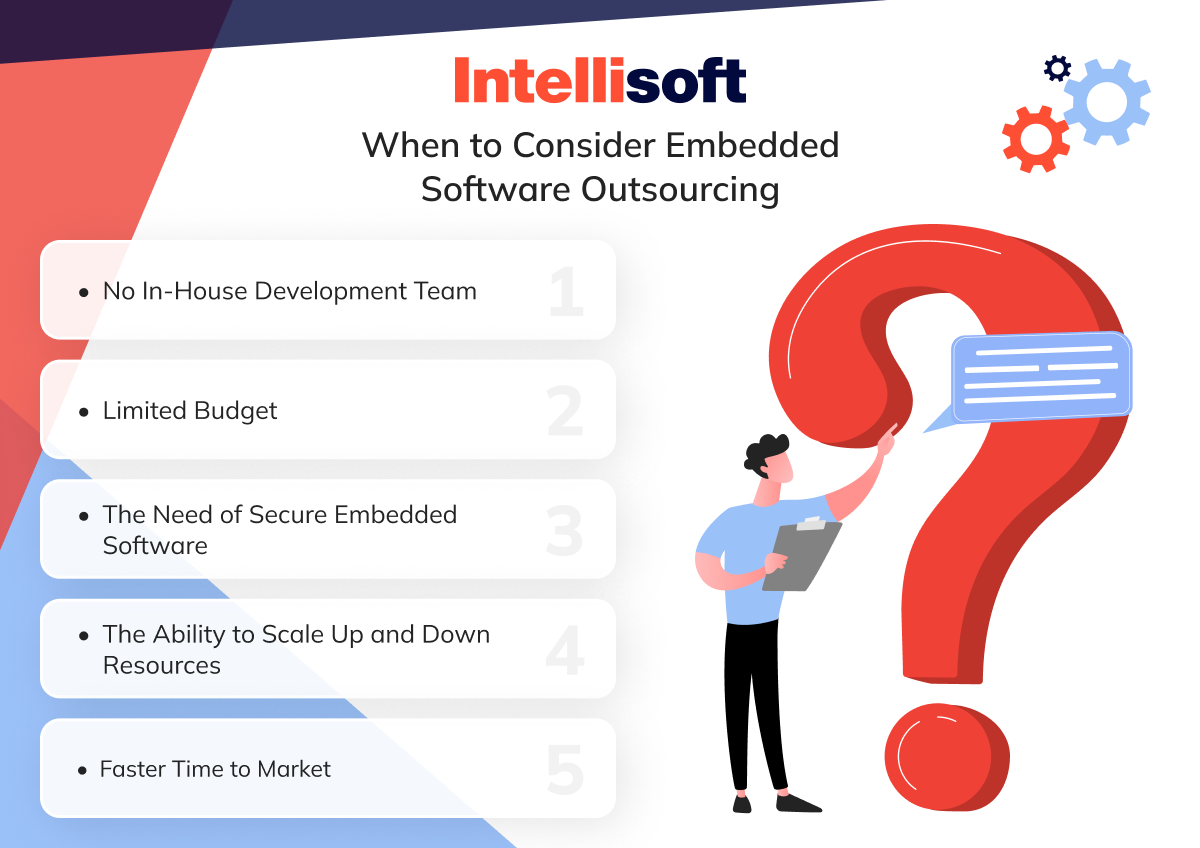
No In-House Development Team
If you’re a startup or small business without your own development team, teaming up with a company specializing in embedded software can make all the difference. Let the experts take care of the technical details so you can focus on scaling your business and doing your best. It’s a wise decision that saves you time and energy for the things that truly count.
Limited Budget
Outsourcing this kind of work can help companies save considerably by allowing them to concentrate on their core business functions while delegating specialized tasks, such as embedded systems development to external experts. Many outsourced providers are located in regions with lower labor costs, which enables them to offer more competitive rates and accurate project estimates compared to local firms. Moreover, businesses can bypass additional costs related to higher rent, wages, and employee benefits typically linked to domestic companies.
The Need of Secure Embedded Software
Developing embedded software can be challenging, and running into bugs or unexpected glitches is not uncommon. But when you bring an offshore team on board, you’re not just getting their coding skills—you’re also gaining access to their advanced testing tools and methodologies. These tools allow for deep code testing before the software is ever deployed, making it much less likely that any bugs will slip through unnoticed.
The Ability to Scale Up and Down Resources
Outsourcing embedded development allows businesses to scale their teams without the complications of hiring full-time employees. Your in-house specialists can concentrate on more critical priorities by leveraging an external team to manage essential projects. Additionally, you save on maintaining full-time staff during downtimes, as you only pay for services when required.
Faster Time to Market
Development teams are constantly pushed to deliver products faster. There’s little time for internal tasks that don’t directly influence the final product or service. This is where outsourcing embedded solutions makes a difference. Working with specialized experts can accelerate your progress while ensuring your product complies with all the necessary regulations and industry standards—without the added headache.
How to Find an Embedded Software Outsourcing Company
The surge in embedded technologies’ popularity is mainly due to their transformative effects on electronics, manufacturing, logistics, and automotive industries. These sectors rely on embedded systems to elevate functionality, improve product quality, optimize the management of resources and equipment, and promote reusability. However, development costs steadily rise as technology advances and complex projects grow.
Many companies are now choosing to outsource their embedded software development—an effective strategy to lower expenses, enhance quality, and accelerate time to market.
Looking to unlock the full potential of your embedded software project? Here are some key tips to get you started!
Examine the Expertise and Experience of Your Embedded Software Outsourcing Provider
A trustworthy embedded software outsourcing company should demonstrate a strong track record of successful projects and have deep expertise in both software and hardware for complex embedded systems. Their engineers need to handle every stage of development, from initial product discovery through software creation, quality assurance, and the final steps of product launch, provisioning, commissioning, and, crucially, certification. Additionally, your tech partner’s embedded development team must include a robust number of specialists dedicated to your project. This ensures the ability to scale and evolve your custom-embedded solution as needs grow.
Define the Skills Your Remote Embedded Team Needs to Have
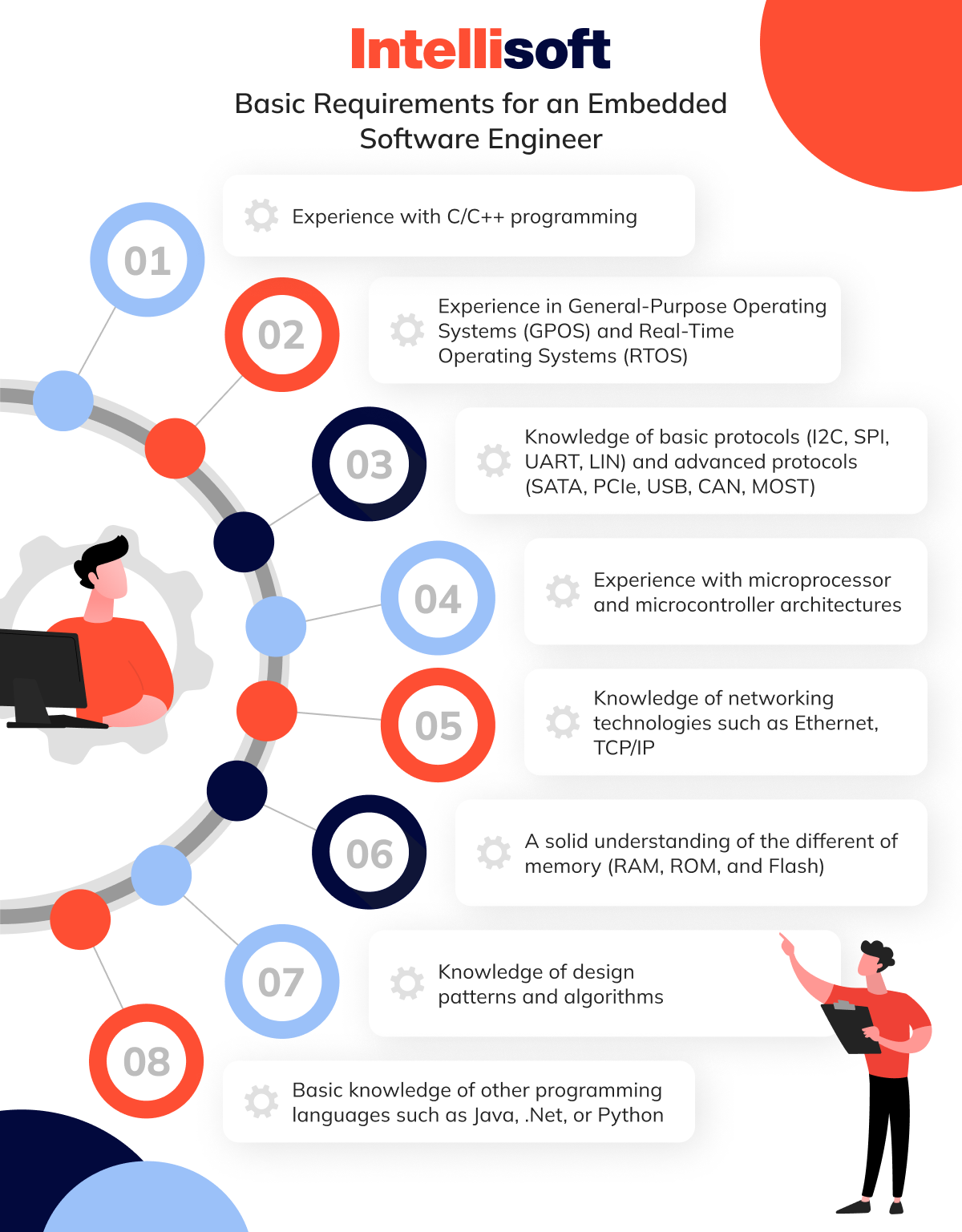
The toolkit for an embedded software engineer can vary quite a bit depending on the product’s complexity and the specific demands of a project. However, certain core skills are essential across the board.
- Solid understanding of General-Purpose Operating Systems (GPOS) and Real-Time Operating Systems (RTOS). These operating systems serve as the foundation for most embedded systems. GPOS provides flexibility, while RTOS ensures precise and timely task execution, which are both critical in this field.
- Proficiency in programming languages, particularly C and C++. These languages are favored in embedded development for their efficiency and ability to interact directly with hardware. Depending on the project’s requirements, knowledge of additional languages such as Java, .NET, or Python can also be helpful.
- Firm grasp of theoretical concepts. Algorithms, design patterns, and data structures are essential for organizing and managing information within the system. A strong understanding of control systems is equally important, as they frequently govern how components interact within an embedded system.
- A good working knowledge of networking. Engineers must be familiar with Ethernet and TCP/IP technologies to enable communication between devices and systems and ensure seamless interaction with other hardware or networks.
- A solid background in computer hardware. Engineers should be familiar with memory types such as RAM, ROM, Flash, microprocessor, and microcontroller architectures. Understanding data exchange protocols completes the toolkit, equipping engineers to build robust and efficient embedded systems.
Team Up with a Development Partner that Has a Solid Understanding of Hardware Capabilities
The team embedded plays a crucial role in maximizing the capabilities of hardware components, ultimately enhancing the user experience. Embedded engineers must deeply understand the hardware they’re working with to achieve this. Each project has specific needs, requiring different processing power, memory, and storage levels, whether HDDs or SSDs.
These requirements fluctuate significantly depending on the application and the system’s environment. Engineers must meticulously fine-tune configurations, considering component size, CPU, memory, storage, and input/output systems.
Choosing the right technology partner for embedded projects involves more than finding a team with expertise in embedded computing. Collaborating with an embedded software team lead who stays updated on the latest processor technologies, and offers innovative solutions to tackle complex challenges, is also essential.
Use Agile Development Strategies to Maximize Project Efficiency
Managing projects in the tech sector often brings up familiar hurdles—extended development cycles, missed deadlines, unpredictable schedules, and even burnout among engineers. These challenges are prevalent in embedded software development. One highly effective way to tackle them is by adopting Agile methodologies, which can help accelerate development and guide teams through these common obstacles. Applying Agile in scenarios where hardware and software are developed simultaneously might require some outside expertise to make it work seamlessly.
To set up a solid Agile workflow, you should think about the following team aspects:
- Approach
- Structure
- Size
- Tools
- Practices
- Metrics to measure success
Start by taking stock of the current environment and the product’s architecture to create a solid foundation for future work. From there, Agile principles can help shape a release plan based on milestones, even when dealing with hardware development.
Since testing is vital in most embedded systems, weaving testing activities into Agile cycles is important. Dedicated testing teams should regularly conduct functional, scalability, and system-level tests to keep everything on track.
Another essential strategy is gradually decoupling the product architecture. By doing this, teams can quickly modify, build, and test individual components or layers. This method not only improves performance but also speeds up delivery. Plus, it encourages early customer feedback, allows continuous testing, and offers faster insights into potential risks.
Don’t Underestimate the Flexibility Factor
Finding engineers who can adapt quickly is essential when selecting embedded software outsourcing providers. Working in embedded development often means tackling new challenges, such as developing prototypes in unfamiliar programming languages or resolving issues in older, legacy systems. A deep understanding of software architecture, event-driven systems, and UML modeling, combined with a flexible approach, is key to delivering top-notch results.
Another crucial factor is the provider’s ability to scale the team quickly. Since adjusting the team size can take anywhere from one to three months, it’s important to establish reasonable notice periods upfront to keep the project running smoothly without delays.
Developing embedded systems can quickly become overwhelming for many businesses, as the complexity often introduces risks, delays, and unforeseen challenges. Furthermore, hardware development brings hurdles—expensive prototyping, high manufacturing costs, and the need to meet stringent compliance standards. Despite these significant obstacles, the embedded systems industry is still expected to grow, with forecasts predicting it will reach $139 billion by 2027.
In the early phases of a project, it’s often difficult to anticipate the potential issues that may arise during the hardware and software development processes. These challenges might seem minor at first, so it’s essential to have a highly skilled team of engineers to tackle the complexities as they surface.
Related articles:
- What Is Nearshore Outsourcing in Software Development?
- TOP-10 Programming Languages in Outsourcing Software Development
- Who Does What? Understanding Roles in a Software Development Startup
- 11 Software Developer Soft Skills Every Programmer Needs to Succeed
- How to Extend Your Software Development Team
10 Common Problems of Embedded Projects
Now that we’ve learned the embedded team meaning and ways to find an outsourcing vendor, let’s look at 10 common challenges you can solve with a trusted embedded partner.
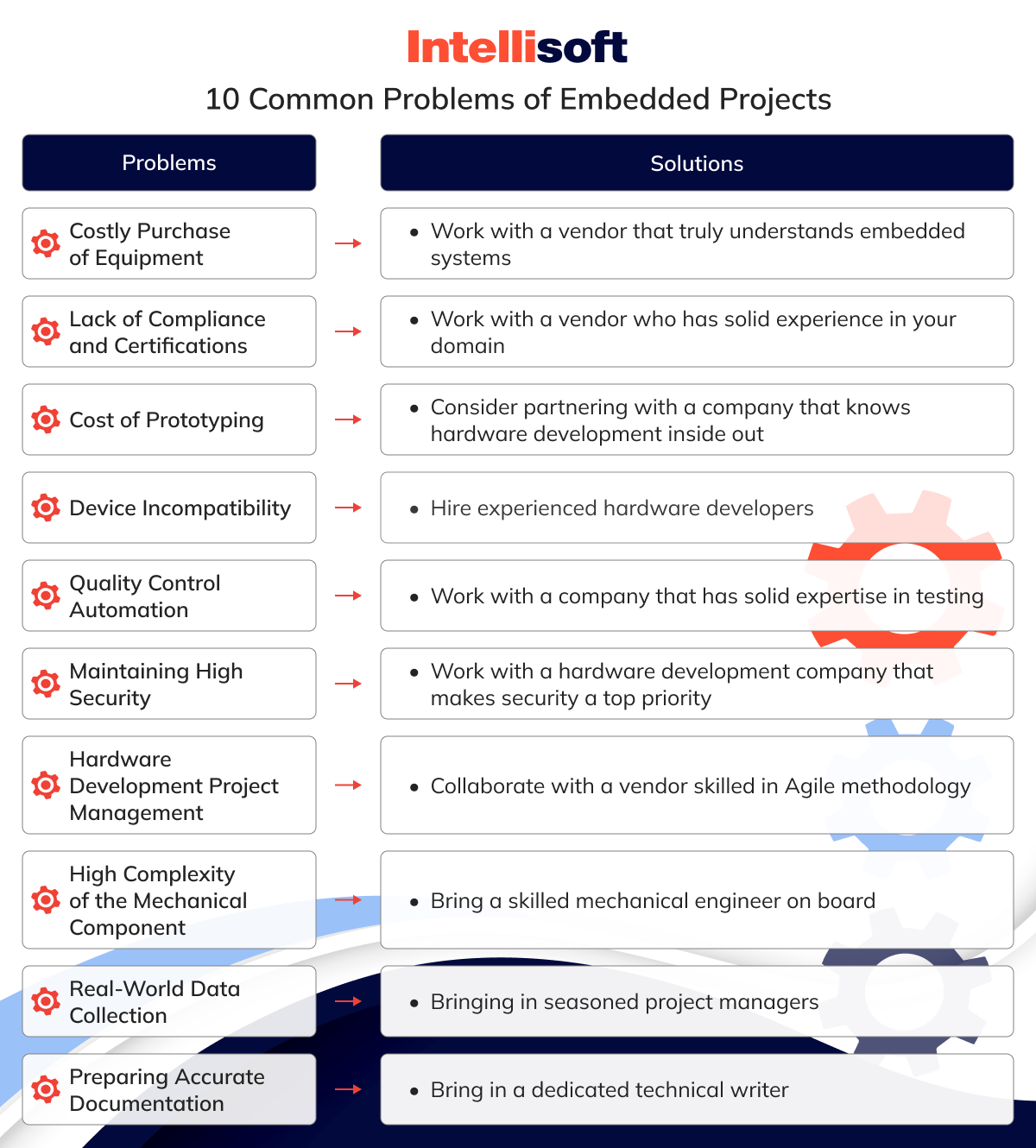
Costly Purchase of Equipment
Most programmers need a laptop to get started. However, for embedded engineers, the setup is far more involved. These professionals rely on specialized tools such as developer kits equipped with application processors, microcontrollers, and sometimes even precision instruments, such as multimeters, oscilloscopes, or logic analyzers. Naturally, the cost of these tools can add up fast.
Solution: work with a vendor that truly understands embedded systems
Established vendors already have all the necessary gear and expertise, saving you the hassle—and expense—of setting up a dedicated workspace for your embedded engineering team. This equipment can be reused across multiple projects, making it a smart, long-term investment.
Lack of Compliance and Certifications
Before launching any product, it must comply with specific standards or regulations. In some cases, this might be a mere formality, but other times, it requires thorough testing of each unit produced. For this reason, it’s crucial to determine the necessary certifications for your product even before development starts. These certifications will vary based on your product’s type, the industry you’re in, and the location where it’s sold.
Solution: work with a vendor who has solid experience in your domain
By teaming up with a software outsourcing provider with a track record of success in your industry, you can be confident they understand the certification landscape and know how to guide you.
Cost of Prototyping
Prototyping can sometimes feel overwhelming—it takes time, costs money, and seems like a huge effort. But it’s vital to getting your embedded software and hardware right. A well-examined prototype helps minimize revisions, meaning fewer versions and lower development costs. Sounds good, right? But here’s the thing; not everything needs to be prototyped, and in some cases, the effort can exceed the benefits. For example, some development kits cost as much as making a small batch of prototypes.
Solution; consider partnering with a company that knows hardware development inside out
These experts often have the resources and parts to complete your prototype quickly. Plus, they can leverage long-standing relationships with manufacturers to secure components at prices below market rates, saving you money in the process.
Device Incompatibility
Manufacturers often create embedded devices with specific communication protocols and unique logic, making integrating new devices smoothly into an existing system challenging. This lack of uniformity can lead to serious challenges in achieving seamless interoperability.
Solution: hire experienced hardware developers
A knowledgeable hardware development engineer can cut through the complexity and help ensure smooth integration. Whether developing custom embedded devices that perfectly fit your system, or ensuring everything works well when connected to the Internet, skilled developers ensure your devices function cohesively within your ecosystem.
Quality Control Automation
Testing is vital to ensuring the product development process goes smoothly, as it helps detect small issues before they grow into larger ones. Automated quality control plays a particularly crucial role in mass production, helping avoid the expensive hassles of recalling or discarding products that are already in circulation. However, finding the right experts to implement QC automation can be tough.
Solution: work with a company that has solid expertise in testing
Take IntelliSoft, for example—by partnering with them, you’ll benefit from a comprehensive test automation framework and detailed test cases to ensure your product operates seamlessly. IntelliSoft team can automate various testing processes, whether Smoke, User Acceptance, or Black Box testing, to ensure your product remains reliable over time. From selecting or building custom test frameworks and covering complete functionality with robust test sets to integrating with CI/CD pipelines for ongoing automated testing and setting up appropriate test environments, IntelliSoft covers all your needs. If your project involves hardware, IntelliSoft brings valuable experience developing test setups for development and mass production quality control.
Maintaining High Security
Security is paramount now, particularly for embedded systems. Threats are everywhere—from physical device theft to data manipulation—making businesses vulnerable to significant risks.
Solution: work with a hardware development company that makes security a top priority
A solid, secure system architecture is critical to the success of any embedded solution. Potential dangers are ever-present, whether it’s preventing data breaches, service hijacking, or denial-of-service attacks. That’s why it’s crucial to embed security from the very start of the design process. An experienced team can develop a high-performance system architecture, utilizing DevSecOps to integrate top-tier security protocols and threat intelligence, safeguarding your network from attacks and data loss.
Hardware Development Project Management
Three crucial teams work together in an embedded development project; programmers who write the code, hardware developers who design the electronics, and designers who shape the product’s look. While these teams usually operate independently, collaboration becomes essential when progress depends on input from another group.
Solution: collaborate with a vendor skilled in Agile methodology
Agile keeps things moving smoothly by helping project managers anticipate and handle critical team dependencies. This way, hardware developers can steadily push forward, delivering results across software, hardware, firmware, and design phases. It lets stakeholders track progress in real-time, offering chances to fine-tune the project based on user feedback and evolving needs.
High Complexity of the Mechanical Component
Developing embedded projects presents distinct challenges. These can range from technical constraints (such as limited power, tight space, quick response times, and restricted processing capabilities) to business hurdles, such as managing tight budgets. Striking the right balance between these demands makes the process more complex, as the final product must satisfy customer requirements while adhering to these limits.
Sometimes, a device might be mechanically intricate but relatively simple from an electronic standpoint. For instance, a gadget with a few LEDs, a button, and basic parts might not be difficult to handle from a hardware perspective. However, ensuring this setup fits precisely within a sleek, modern casing requires exact component placement and ongoing coordination between designers and engineers.
Solution: bring a skilled mechanical engineer on board
Having an experienced mechanical engineer is crucial if your hardware design is intricate. All parts must work together mechanically and electronically to ensure the product functions flawlessly. An expert hardware engineer can help ensure everything fits and performs as it should, producing a product that looks sharp and operates perfectly.
Real-World Data Collection
Nearly all embedded devices engage with their surroundings, such as monitoring temperature, tracking location, conducting blood tests, or identifying images. However, before this data can be useful, it must be appropriately configured and validated, where mathematical modeling plays a crucial role. Building these models requires real-world data, which can be challenging to obtain due to the need for intricate planning and management.
Solution: bringing in seasoned project managers
These professionals will ensure the data collection process is both effective and precise through careful planning and coordination.
Preparing Accurate Documentation
Managing extensive documentation is a crucial but often time-consuming task in hardware development. This approach includes everything from user manuals and certifications to detailed assembly drawings required for production. Typically, hardware developers themselves are responsible for creating and organizing these documents. However, this isn’t always the most efficient use of their time, as their expertise lies in embedded software and hardware design.
Solution: bring in a dedicated technical writer
This professional doesn’t necessarily need an engineering background but should have experience dealing with regulatory bodies, an understanding of documentation standards, and familiarity with design requirements. By doing so, hardware developers can stay focused on their core responsibilities, leading to greater efficiency and smoother project execution.
As Michael Harris, a Software Engineering Specialist, said, “The key to successful embedded software outsourcing lies in collaboration and clear communication between the client and the external team.”
Embedded Software Outsourcing with IntelliSoft
Cambio Healthcare Systems set out to enhance its healthcare offerings by incorporating sophisticated ICU management features to improve patient outcomes. This endeavor required advanced expertise in embedded software development to deliver a solution aligned with the healthcare industry’s highest standards.
IntelliSoft was chosen for this initiative due to our proven experience in embedded software development and our deep understanding of the healthcare domain. We worked closely with Cambio to integrate Daintel’s cutting-edge ICU functionalities into their existing systems. This project required meticulous attention to detail, real-time data processing, and a comprehensive understanding of the healthcare environment from both hardware and software perspectives.
This is how we did it:
- Comprehensive requirement assessment. We started by conducting an in-depth analysis of Cambio’s systems and ICU needs to grasp the project’s full scope and specific objectives.
- Customized software development. Leveraging our expertise, we developed tailored embedded software that integrated seamlessly with Cambio’s healthcare platform.
- Thorough testing. The solution underwent rigorous testing to meet industry reliability, stability, and regulatory compliance standards.
- Smooth system integration. Our team successfully integrated the ICU functionalities without disrupting operations, improving patient care and smoother workflows.
Our experience and approach led to the following results:
- Improved ICU management. The new integration equipped Cambio with enhanced tools for monitoring and managing ICU patients, significantly elevating the quality of care.
- Operational efficiency gains. The smooth integration process enabled Cambio to streamline its operations, improving efficiency.
- Client satisfaction. Cambio Healthcare Systems commended IntelliSoft for our deep technical expertise, commitment to high standards, and timely delivery of a robust solution.
This successful partnership between IntelliSoft and Cambio Healthcare Systems underscores the benefits of outsourcing specialized software development. Our ability to understand intricate healthcare requirements, deliver custom-fit solutions, and ensure a smooth integration process has further solidified our reputation as a trusted technology partner in the healthcare sector.
Conclusion
Outsourcing software development can be a game-changer, especially in the embedded software sector. By teaming up with global talent, companies can cut down on costs, quickly expand their teams, and stay laser-focused on what they do best. It’s a smart move that lets businesses tap into specialized expertise without losing the flexibility to adjust to evolving project needs.
At IntelliSoft, we make this process smooth and hassle-free. With our extensive experience in embedded software development, we offer outsourcing solutions tailored to your specific project goals. Whether delivering a project on time or providing ongoing support, you can count on us to deliver high-quality results every single time.
Contact us today. Let’s work together to streamline your development process and set you up for long-term success in this fast-paced industry.










